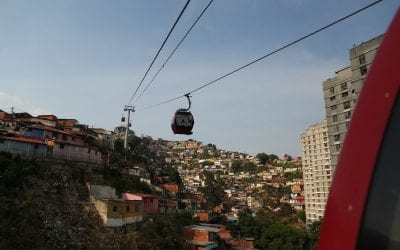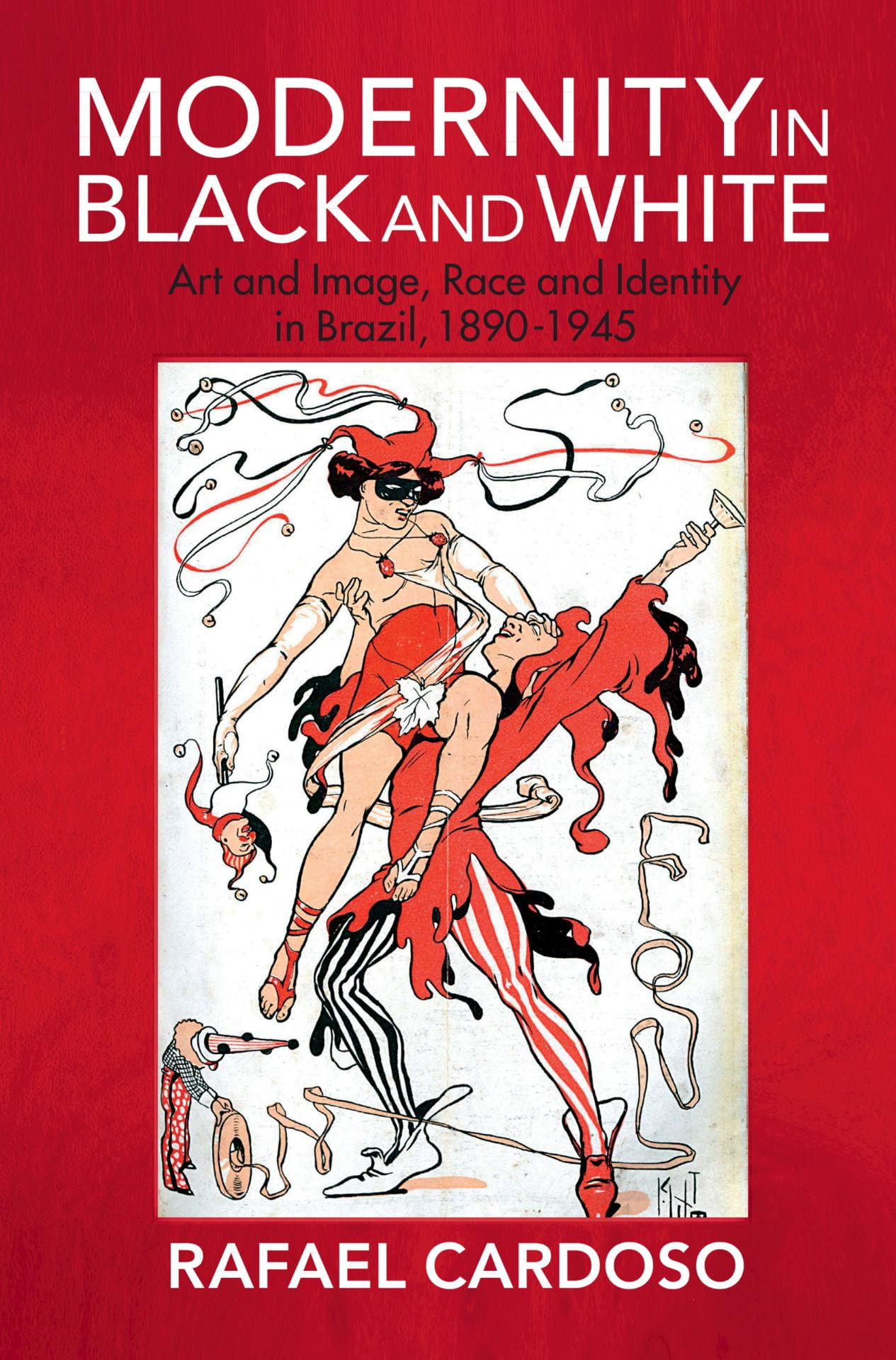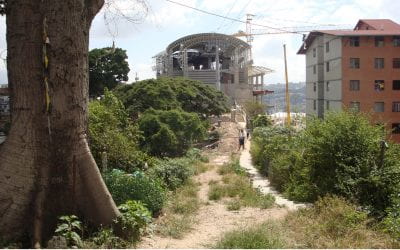Improving Public Transport
Key Elements for Reform
The prospective passenger makes a slight movement—no need to even raise the arm to flag the combi (but that can also help)—and the driver will slow down. The yelling guy will confirm the destination with the would-be passenger while the vehicle is still moving, albeit slowly. If the destination is acceptable, he will open the door of the combi—a small van for 10 to 12 passengers plus the driver—and let the passenger in. The user will pay with cash. This cash, times the number of riders throughout the day, paid the drivers and helper, as well as the investment and operating costs of the combi.

“Colombia: Riding the Buseta” by eliduke is licensed under CC BY-SA 2.0
Years earlier, walking with my mother by the National Pedagogical University of Colombia in Bogotá I saw a female student flag a buseta—a 24-foot-long vehicle for 30 to 40 passengers. The driver—no helper used in Bogota to lower costs—slowed down but did not stop completely. This woman knew from past experience she had to quickly climb the 1.5-ft-high first step—but could not fast enough. The driver briskly accelerated because the Guerra del centavo—penny war—demands chasing every possible passenger as fast as possible. The woman, unfortunately, lost her balance and fell backwards onto the pavement. My mom and I rushed to help her. Her first words: “I’m okay, but when will we have better public transport? I have fallen inside the bus also.” We took her to a nearby health post and she was released soon after.
Penny war is a colloquial term invented in Colombia to describe this way of organizing public transport, all too common in developing countries. In economic terms, this arrangement is known as competition in the market which works for selling bread or television sets, but not for a high-quality public transport.
Penny war: benefits and costs
In competition in the market, each bus or public transport unit is owned by one or more people, one of whom might be the driver. This arrangement allocates risk to the bus owner. The owner loses money if not enough passengers ride the bus. To mitigate the risk, bus owners rent out the bus to the driver. This move effectively transfers the commercial risk to the driver. The driver must carry enough paying passengers to cover the rent on the bus, plus fuel, cleaning, maintenance and his income (women are rarely drivers). The result is cutthroat competition for each additional passenger. Drivers careen their units in search of an extra passenger. Drivers can avoid fully stopping their bus to pick up or drop off passengers which is very dangerous for the users, as shown above.
In other cities, bus companies own the buses, but the incentives are similar if routes overlap. Buses of one company compete for each additional passenger against the buses of all the other companies. In some settings the bus companies do not own the buses; rather, they own bus routes, under a government-issued permit. The bus company periodically charges a fee to the bus owners. The bus company faces no risk, which is entirely allocated to the bus owners or, if the bus owner rents out the bus, to the drivers. These bus companies maximize revenue by having more routes that can be rented out to more bus owners which also increases frequency of service.
Frequency is indeed a critical component of good-quality service, because users want to minimize time waiting for the bus. These preferences generate incentives to provide more frequent service: bus companies and bus owners invest in more buses. Authorities issue permits for more buses. In some cities permits never expire. While users benefit from shorter wait times, demand seldomly grows as fast. The result is a decreasing productivity measured, for example, as passengers per day per bus or passenger per mile logged per bus. As these indicators go down over time, profitability also decreases.
Bus owners are drawn to buying inexpensive used buses. The incentive is also to buy smaller and smaller buses. Cities can start with 36-feet long buses for 80 passengers and good frequency of service and end with thousands of mini-buses for eight to 12 passengers. The predatory competition continues among the mini-buses deepening the vicious cycle. Some cities end up with motorcycles that provide public transport service (e.g., moto-taxi). In the end, there can even be an oversupply of buses. In economic terms, in competition in the market there are low barriers to entry to compete in this market—buses can be added at a low capital and transaction cost.
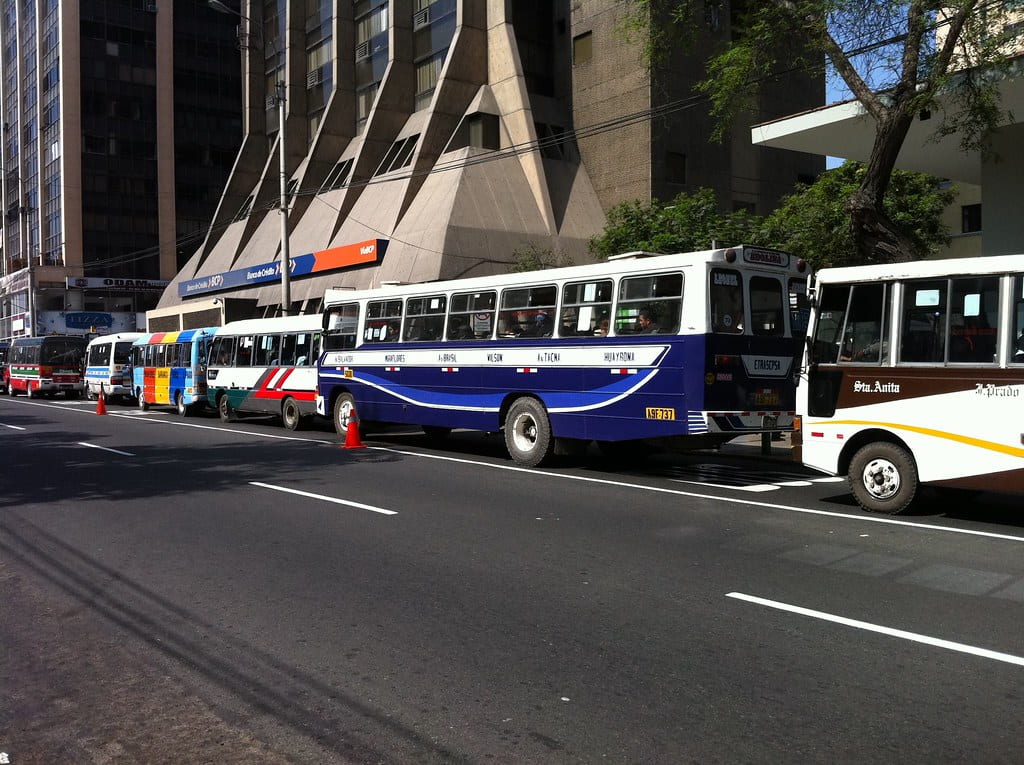
“Bus in Lima” by comicpie is licensed under CC BY 2.0
Thousands of engines mean also more greenhouse gas emissions and lower air quality. In African as well as in several Latin American cities such as Bogotá and Lima, mini-buses are prevalent, and few large buses remain. Other cities import fully depreciated mini-buses from cities in other developing countries. While used cars can have 125,000 miles logged, these mini-buses could have over 300,000 and even one million at the time they were exported. At arrival, the engines go through some maintenance and then enter service on the city streets. These engines pollute a lot because of their old age. Also, the vehicles lack emission control technologies and filters. Quality of fuels also plays a role. Diesel fuel with very large sulfur content coupled to old engines results in very large pollutant emissions. Air quality deteriorates quickly.
The positive side is that frequency of service will be high, wait times short, and routes will cover a significant part of the city—the slum areas, informally developed might have feeder services using old sedans or people might walk long distances if roads do not allow motorized vehicles. These incentives result in public transport networks that move thousands per day making the city work.
Competition in the market delivers public transport service, but at the expense of air quality and road crashes, all the time exploiting drivers who are informally employed. The drivers, for one, work very long hours, experience high stress, and can even be in charge of maintaining their vehicle. The drivers only make income if they carry passengers above a quota. Few have medical insurance or retirement benefits. The cut-throat competition coupled with the long work hours translates into crashes that kill and injure people—frequently the user. Air quality suffers because of the thousands of old buses and other vehicles on the road. Reforms along the lines of competition for the market , as we’ll explain below, have improved public transport and formalized labor.
Improving public transit services: Competition and remuneration
Latin American countries are at the forefront of public transport reforms. Curitiba (Brazil), Quito (Ecuador), Bogotá, and Santiago (Chile) are some of the examples.
Improving public transport must have as a primary objective to improve the service provided to the user. Improving public transport must provide frequent service, decrease total travel time and improve reliability, as found by at the World Bank. If the reform creates transfers for some users, then total travel time must go down to compensate for the discomfort caused by the transfer.
To meet these goals, improving public transport has—broadly speaking—two essential parts. The first is moving toward competition for the market and away from competition in the market. In competition for the market, the government competitively selects operators that must meet quality standards measured through key performance indicators. The contracts have also a clear end date and define the risk allocation between operators and government—which in turn determines the remuneration to the operators. Competition for the market delivers all its benefits if there are barriers that prevent competitors from entering the market to compete. The competition took place for the right to operate for example by offering a low price per mile logged.
Bus rapid transit (BRT) is a technology developed initially in Curitiba and then emulated by Quito, Bogotá and then many cities around the world. BRT allocates exclusive busways to the authorized buses—selected under competition for the market arrangements. These buses are different from the regular bus because the doors are wider and dock to a station to pick up passengers at grade. Passengers must climb no steps—ramps that provide access to the stations from the street also help people in wheelchairs. Regular buses with two or three steps to climb cannot dock at these stations—in some cases the doors are on opposite sides. BRT is the best example of introducing barriers that protect the operators who won the right to operate through competition for the market. These operators won the right to operate through a competitive bid, but do not face direct competition after.
Upgrading streets including sidewalks, the carriage way and intersections improve traffic flow for all users: pedestrians, bicyclists, public transport riders and car users. In all cases, authorities can couple improvements in the infrastructure in the corridor with small steps towards competition for the market. The key is that since authorities ask an operator to improve service, they must protect that operator from predatory competition. The operator is taking some risks. If predatory competition happened, then the operator will lose its investment in new buses, for instance. The key is to understand that users favorably respond to frequent and reliable service.
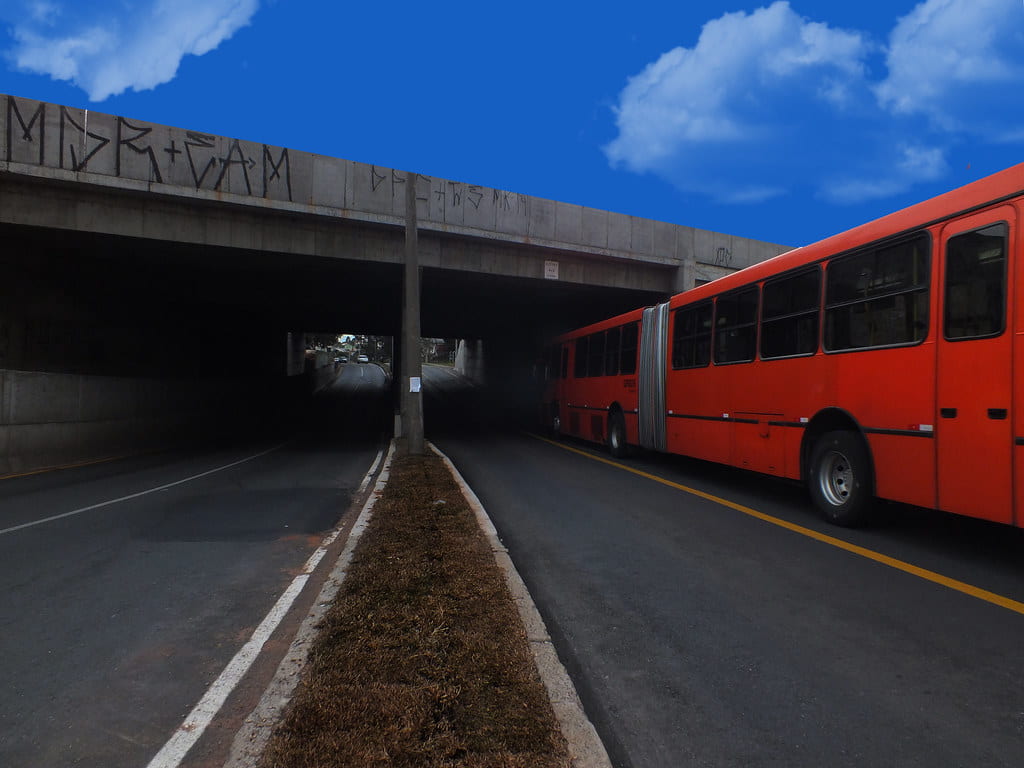
“BRT Curitiba (PR)” by Programa de Aceleração do Crescimento (PAC) is licensed under CC BY-NC-SA 2.0
In all cases, previously existing bus routes need to be restructured. The BRT routes will be new and operate only within the corridor alignment. The bus routes that used to operate in that corridor cannot run anymore and must be realigned—sometimes becoming feeders to the mass transit service provided by the BRT. Route restructuring calls for ample consultations with affected operators to find creative solutions. Sometimes, authorities ask the new BRT operators to buy and scrap some old buses for every new BRT bus. This purchase compensates the owner of these buses that will be replaced.
Competition for the market has the additional benefit that authorities demand that operators become formal and employ drivers and mechanics under a formal labor contract. Working hours go down compared to the competition in the market arrangement. Additionally, drivers improve their welfare because they receive health insurance and retirement benefits—absent also in competition in the market. Formal employment can also draw more women to jobs such as drivers and mechanics because they pay better than cleaning jobs usually assigned to women—as shown in a recent publication comprehensive publication on transport and gender. Note that when a city implements a metro line, the expectation is that all employees will be formally hired by the metro operator.
The second important part in the reform of public transport is to separate what users pay—the farebox—from the remuneration to operators for service rendered. In competition in the market, the tariff times the number of passengers carried in a day is the remuneration to the driver, who then pays for rent on the bus, cleaning and some maintenance. This figure allocates the risk of not having enough ridership to the driver. The result is cut-throat competition with very negative consequences on road safety and air quality.
The first step to separate farebox from remuneration is to group the farebox at the route, bus company or city level. Bus owners in a route will be remunerated not daily but, for instance, weekly. The change in periodicity allows buses to rest one day for proper maintenance. All buses in the route will provide service six out of seven days. No bus has an advantage, and all make the same income on average. This change also allows drivers to rest once a week—a welcomed change because competition in the market means that a driver is almost always working. Drivers who rest are less prone to crashes, more so if they do not have to aggressively compete for each additional passenger.
Improving public transport is not easy and costs usually increase. For example, adopting competition for the market implies stronger contractual relationships between the authority and the operator. Drivers also become formal employees, as explained above. Formalizing transport increases costs versus competition in the market in which drivers provided implicit subsidies to bus and route owners—drivers operating as their own mechanics in some cases. This increase in cost validates why reform implies also separating the farebox from the remuneration to operators. To cover operating costs, explicit subsidies might be needed.
Yet these reforms do not operate in a political vacuum, as Diane Davis of the Harvard Graduate School of Design reminds us in her article in ReVista and in my own work. Assume a city implemented one BRT line. Some existing bus operators can lobby to get a new route that indirectly competes against the BRT service. These operators can claim they serve a different market segment. Soon after, other routes emerge. Worse is if planners did not correctly value the onerous cost of transfers from feeder to trunk buses in the BRT. Some people will prefer a direct route in mixed traffic over a feeder bus and transfer to a BRT. More routes can emerge to satisfy this demand.
This example actually illustrates the next step in the reform pathway. Cities such as Curitiba (Brazil), Santiago (Chile) and Bogotá have realized that the next step in the reform is to move the entire city to competition for the market. Specifically, the city is split into exclusive areas where only one competitively selected operator can run bus services, meeting performance indicators, and for a certain number of years. The operators design the routes in agreement with authorities. Usually, the central business district is open to all operators because of the high density of destinations. The exclusive areas work if the farebox is also unified at the city level and if remuneration is separate from the farebox, as explained above.
Reorganization of public transit operators into “companies” competing for the market can provide new avenues for accessing government incentives or commercial financing for the introduction of better buses—either more efficient internal combustion engine vehicles or electric—with lower carbon footprint.
In addition, reforms and fleet renewal provide opportunities to better address the needs of women. Improved frequency and quality of service with operational organization can reduce wait times for women who transfer. Newer vehicles can be better designed with areas and seats for women with bags or escorting children and can provide holding bars or straps at a more comfortable height for women passengers. Furthermore, if electronic fare collection systems are implemented, the signal in the card reader can be strengthened so women can swipe the purse and not the card and thus save the time spend looking for the farecard.
Reforms of public transport can take years even decades. Yet improving travel conditions is central to benefit the passenger and workers and to offer an alternative to driving cars or motorcycles. Competition for the market offers a pathway for improvement. People working in public transport will benefit from being formally employed. The driver and the helper in the combi in La Paz will have medical insurance and pension—something they can never dream of as long as they are in the guerra del centavo. The drivers no longer compete with each other in a cutthroat fashion, as the long-ago student in Bogotá learned the hard way. As my mother and I rushed to help her as she fell from a buseta fighting its penny war, she cried out about the state of transportation in the city. The words have always stuck in my memory.
Fall 2021, Volume XXI, Number 1
Related Articles
Editor’s Letter: Transportation
Bridges. Highways. Tunnels. Buses. Trains. Subways. Transmilenio. Transcable. When I first started working on this issue of ReVista on Transportation (Volume XXI, No. I), I imagined transportation as infrastructure.
Modernity in Black and White
For years, one of my favorite pieces in the Museo de Arte Latinoamericano de Buenos Aires (MALBA) was the iconic Abaporu (1928), by Brazilian artist Tarsila do Amaral: a canvas…
Transportation Itself Does Not Build Urban Structures
English + Español
Fina Rojas lives in the 19 de Abril at Petare, the densest and one of the largest self-produced neighborhoods in Latin America. Most researchers and policymakers define self-produced neighborhoods as “informal settlements.” However, these settlements occur from…

